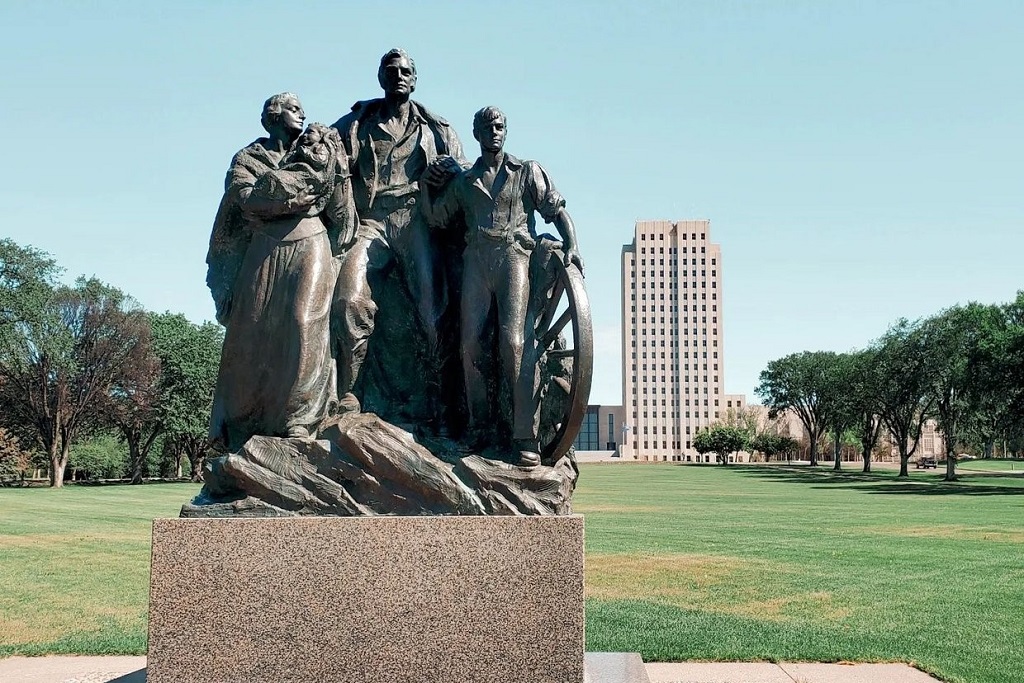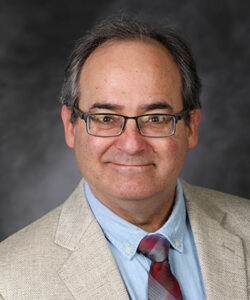‘Pioneer Mother’ monuments in a changing time
Controversy and compromise mark these monuments, which are common throughout the American West, UND professor tells University Council for Women+

Back in June 2020, about two months after the death of George Floyd in Minneapolis, UND Professor Cynthia Prescott was talking with her mother about monuments, then and now.
Specifically, Pioneer Mother monuments, the subject of Prescott’s extensive and award-winning historical research. The University of Oregon boasted one famous example; the statue sat not far from a so-called Pioneer Father monument, and campus tour guides made an effort to point out both landmarks to groups of prospective students.
In the wake of Floyd’s murder, Prescott’s mother pointed to statues being torn down by protesters and asked, “Is anyone threatening to tear down any of your pioneer mothers lately?”
Prescott responded, “No, they’re not coming for the Pioneer Mother. They’re never going to go that far.”
In fact, the University of Oregon’s Pioneer Mother and Pioneer Father would be toppled mere hours later. “So that’s how quickly these things were happening in 2020. It was so fast that I couldn’t even keep up with it,” Prescott said.

A UCW+ event
Prescott told this story as part of a talk she gave about Pioneer Mother monuments to UND’s University Council for Women+. Formerly the President’s Advisory Council on Women, the group changed its name some months ago to reflect a change in its mission, said Stacey Borboa-Peterson, staff co-chair, to UND Today.
“When we looked at the name, we were thinking, does the president really need to be advised about women? Or does the University collectively need a group that focuses on women, on the role that they play within the institution, and on advocacy for them?”
The name-and-mission change proceeded, with President Andrew Armacost’s support. Now, the group meets monthly and hosts social, informational and other events, including the talk that Prescott gave in the Memorial Union in late March.
March is Women’s History Month, and Cynthia Prescott is a historian, noted Yvette Koepke, faculty co-chair of UCW+, in her introduction. “And Dr. Prescott’s work shares the goal that is the goal of both the UCW+ and Women’s History Month, which is visibility.
“To quote from President Biden’s proclamation for March as Women’s History Month 2023, ‘We are mindful that we are guided by and building on the legacy of both recognized trendsetters and trailblazers and unsung heroines who have guided American history and continue to shape the future.’”

Research focus evolves
In her talk, Prescott said she’d started her research on Pioneer Women monuments throughout the American West with the intention of focusing on gender. “I set out to write about statues of pioneer mothers, and to look at how their depictions of gender varied over time and space,” she said.
But before long, the statues she examined and the histories behind each of them — including the speeches that were given at their dedications — “forced me to see that my project was all about race,” Prescott said.
Most early pioneer statues celebrated whites dominating American Indians, Prescott noted. And even many later statues that show, for example, a stalwart woman wearing a long dress and a sunbonnet, and striding westward while carrying a child in one arm and a rifle in the other, say nothing about the cost of white settlement on Indian lands.
The net result very often suggests “a progression from what in the time was referred to as Indian savagery to white civilization,” Prescott said.
Prescott’s second book, “Pioneer Mother Monuments: Constructing Cultural Memory,” explores this thesis in detail. The book won the 2020 Gita Chaudhuri Prize — an award that recognizes the best written study about women in rural or environmental history — and the 2020 Fred B. Kniffen Book Award, which recognizes the best book about the material culture in North America. (Material culture refers to the physical aspects of a culture — in other words, the objects made or modified by people, ScienceDirect.com notes.)
Another introduction to Prescott’s work can be found in an article she wrote in 2018 for The Conversation.

Newer monuments honor inclusivity
Taken as a whole, Prescott’s analysis shows why pioneer statues in the West have become sources of controversy, much like Confederate statues in the East — and why some number of pioneer statues have been removed, either by protesters (as at the University of Oregon) or by civil authorities, as in San Francisco and elsewhere.
But in addition to describing and using slides to highlight some of her earlier findings, Prescott gave the UCW+ audience an update on more recent developments in her field.
For example, “in the 21st century, we’ve started to see more inclusive sculptures — not just pioneer monuments, but depictions of Indigenous people in their own right,” Prescott said.
One of these, titled “Dignity of Earth and Sky,” is a 50-foot-tall representation of an Indigenous woman in Plains-style dress receiving a star quilt. It was put up in 2016 on a site near Interstate 90 in Chamberlain, S.D.
Another sculpture, titled “Dedicated to the Women Leaders of Michigan,” shows an inspirational Native American woman looking out over the landscape. The statue is located near Green Lake in Chelsea, Mich.
The Michigan statue “represents a significant step forward in inclusivity, because by depicting a Native woman to represent all female leaders of Michigan, we see her embodying the values of leadership that are shared by peoples of all populations,” Prescott said.
How communities can respond
“So where does this leave us?” Prescott continued.
City officials and residents of communities with pioneer statues often ask Prescott, What should we do with our statue? “And my initial answer is, ‘It’s complicated,’” she said with a laugh.
“That’s a standard response by a historian. But it really is complicated, because the local response is going to depend very much on the values of that community.”
Prescott’s first suggestion is for local people to learn more about the history of their monument. If that history is objectionable, then removing the statue is one response; but there are others that may be even more appropriate.
For example, some communities have added plaques or labels that add context and “require the viewer to engage with that challenge on the spot.”
And “another response that I’m particularly excited about is the power of counter monuments,” Prescott continued.
In New York City, “Fearless Girl,” a 4-foot-tall bronze statue of a defiant girl, gained fame in 2017 when it was temporarily placed on Wall Street, where it faced down the famous 11-foot-tall, 7,100-pound statue, “Charging Bull.”
The newer statue by a feminist artist “completely transformed the meaning of that bull,” Prescott said.
“This is one of the most powerful things we can do: put up different monuments, particularly placing them in visual conversation with the monuments that we tend to feel are more troubling.”
After Prescott’s talk, Tracy Backstrom, director of Alumni & External Relations for the UND College of Arts & Sciences, said she was grateful to have heard the history professor’s perspective. “Especially because when it comes to understanding women’s place in history, I don’t hear a lot of presentations about that,” she said.
“So being able to listen to Cindy say, ‘This is how women were depicted,’ I really appreciated her insights. And she made me think that the next time I go someplace where there’s a statue, I’m going to be paying a lot more attention.”



